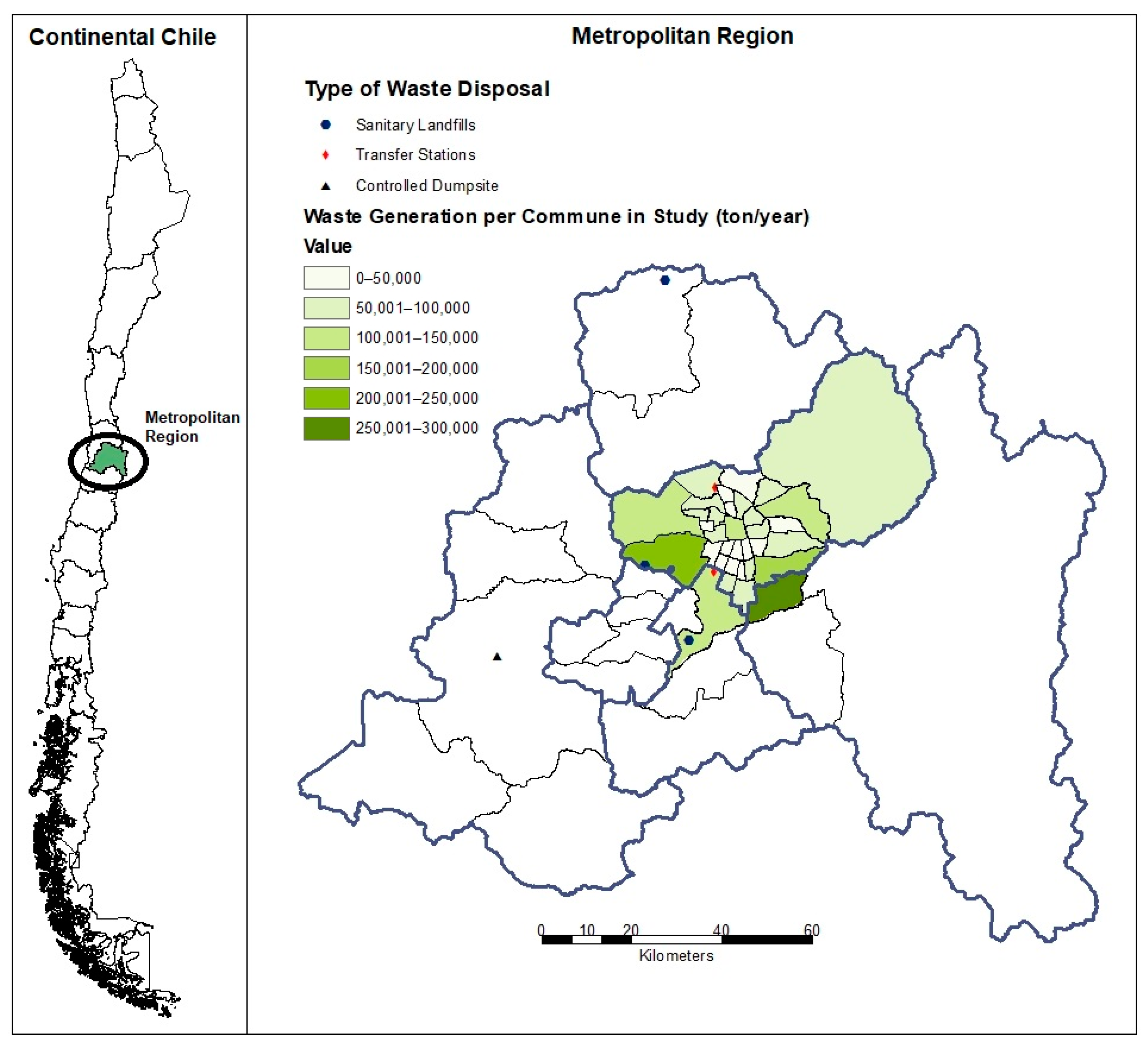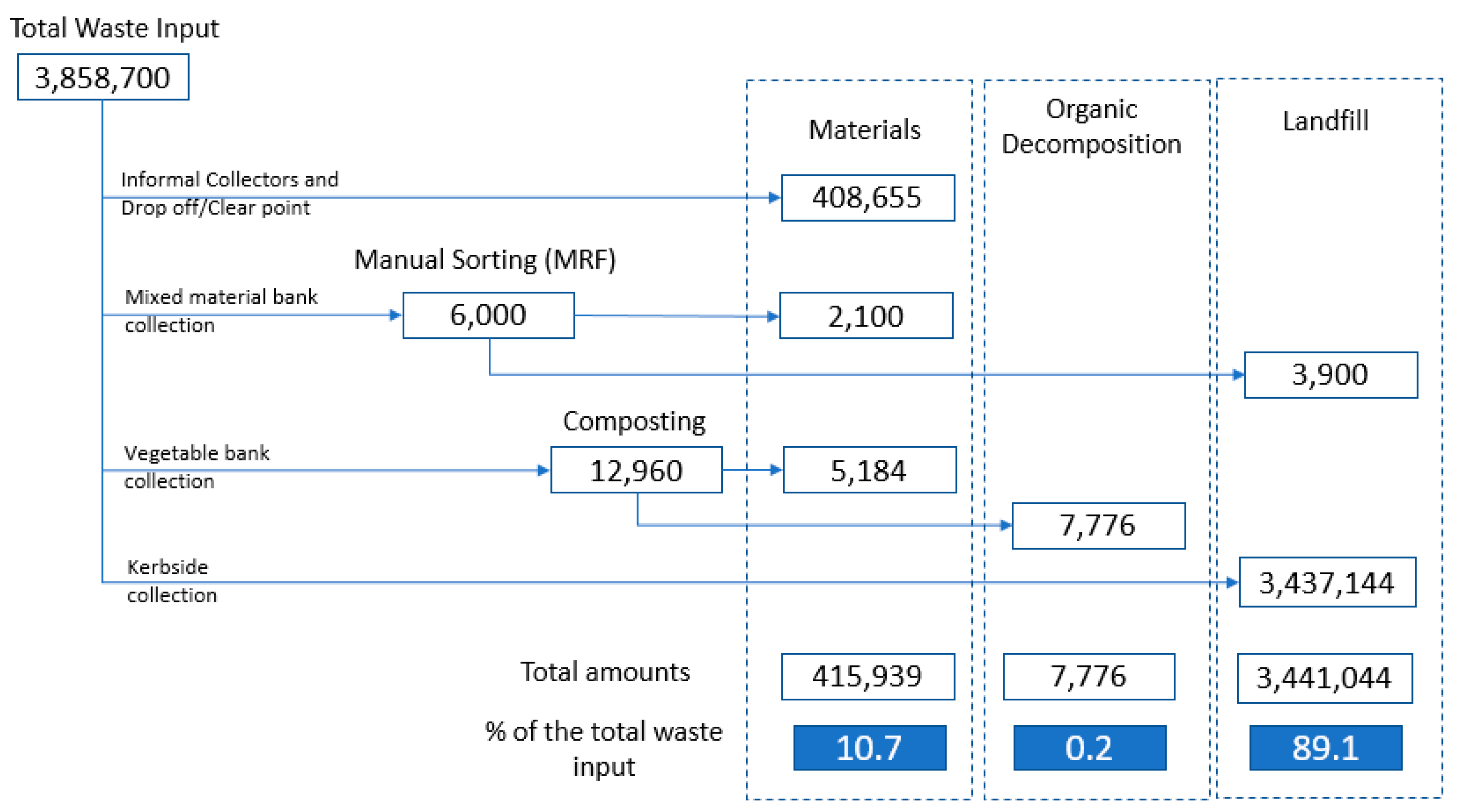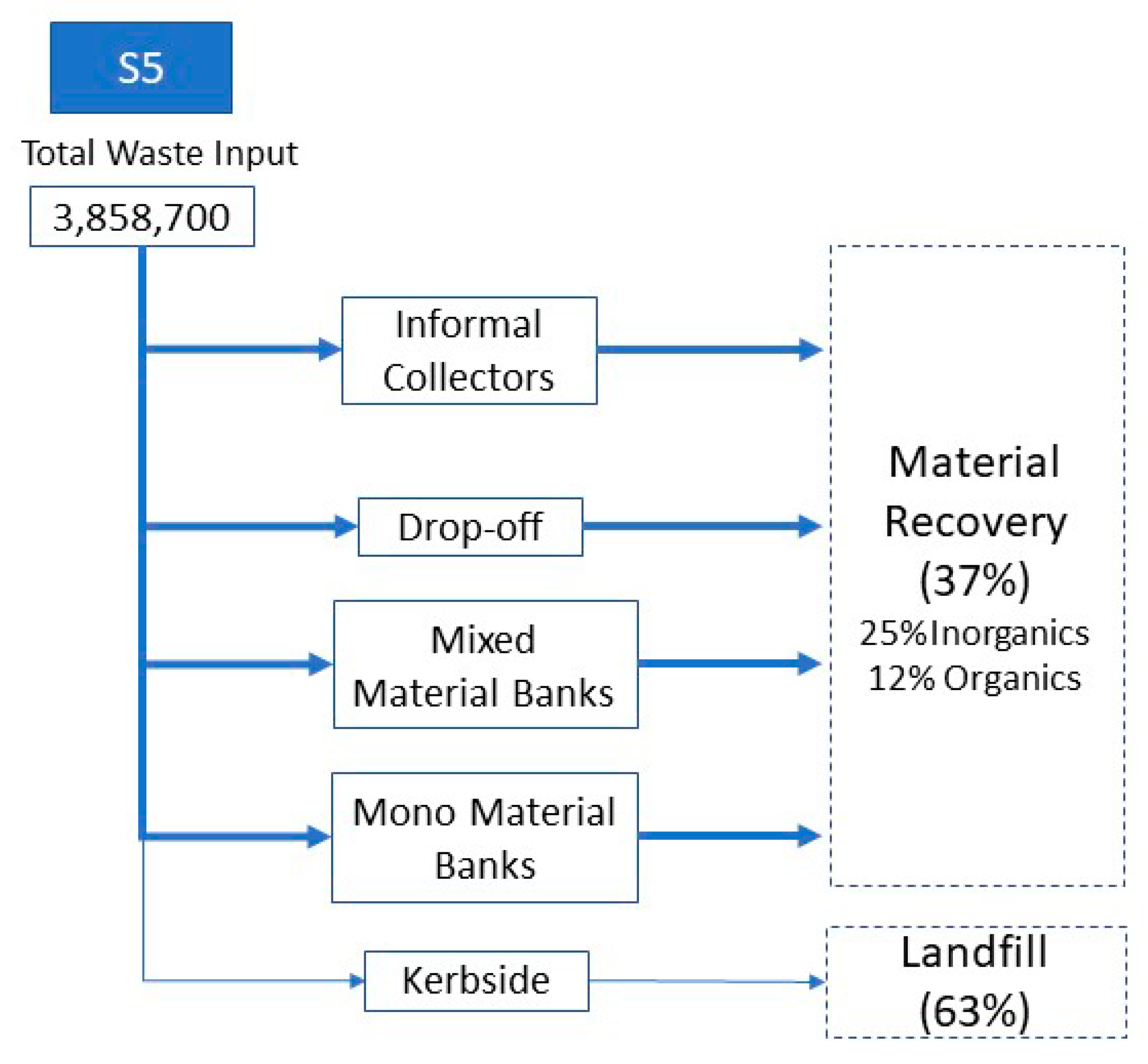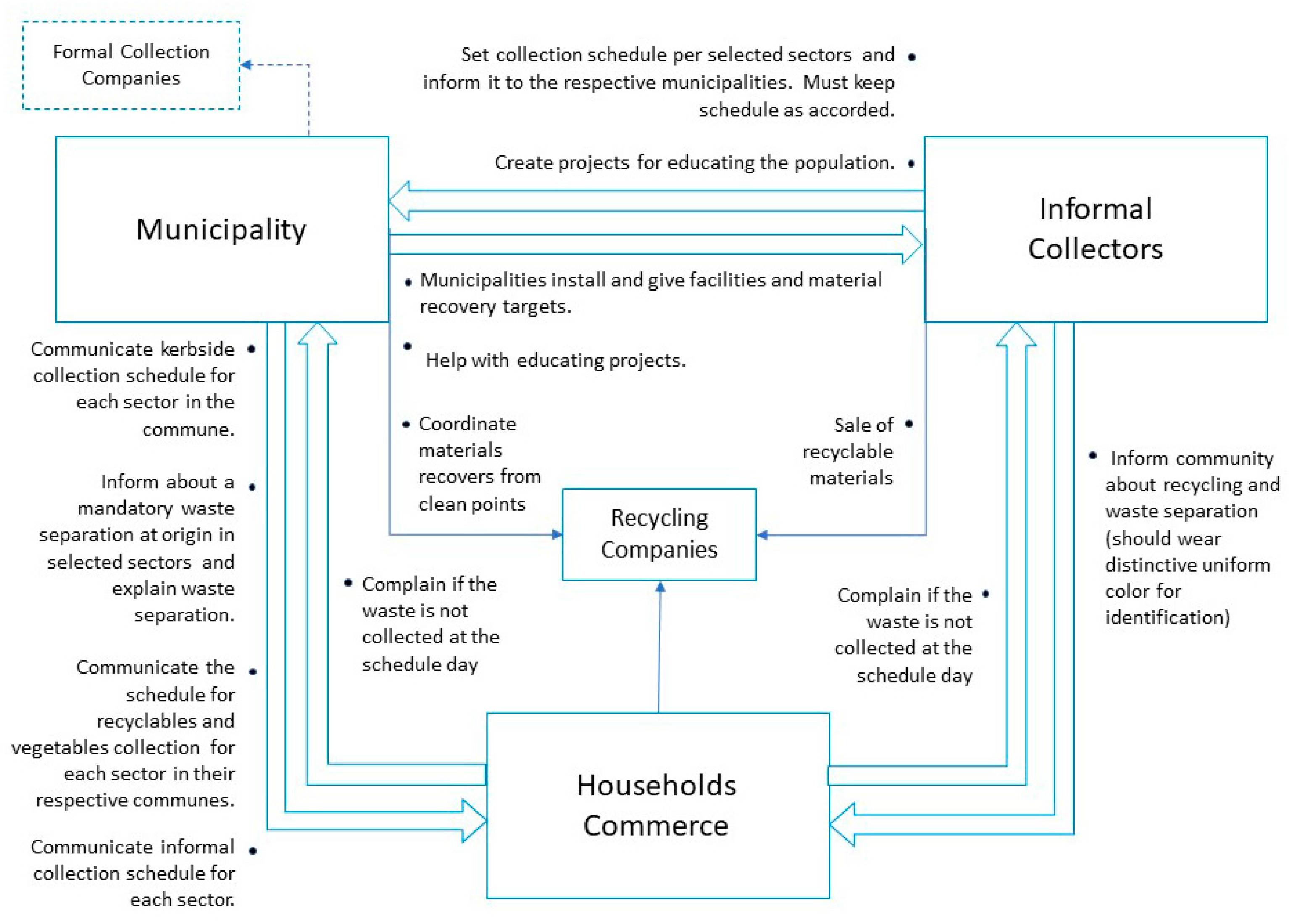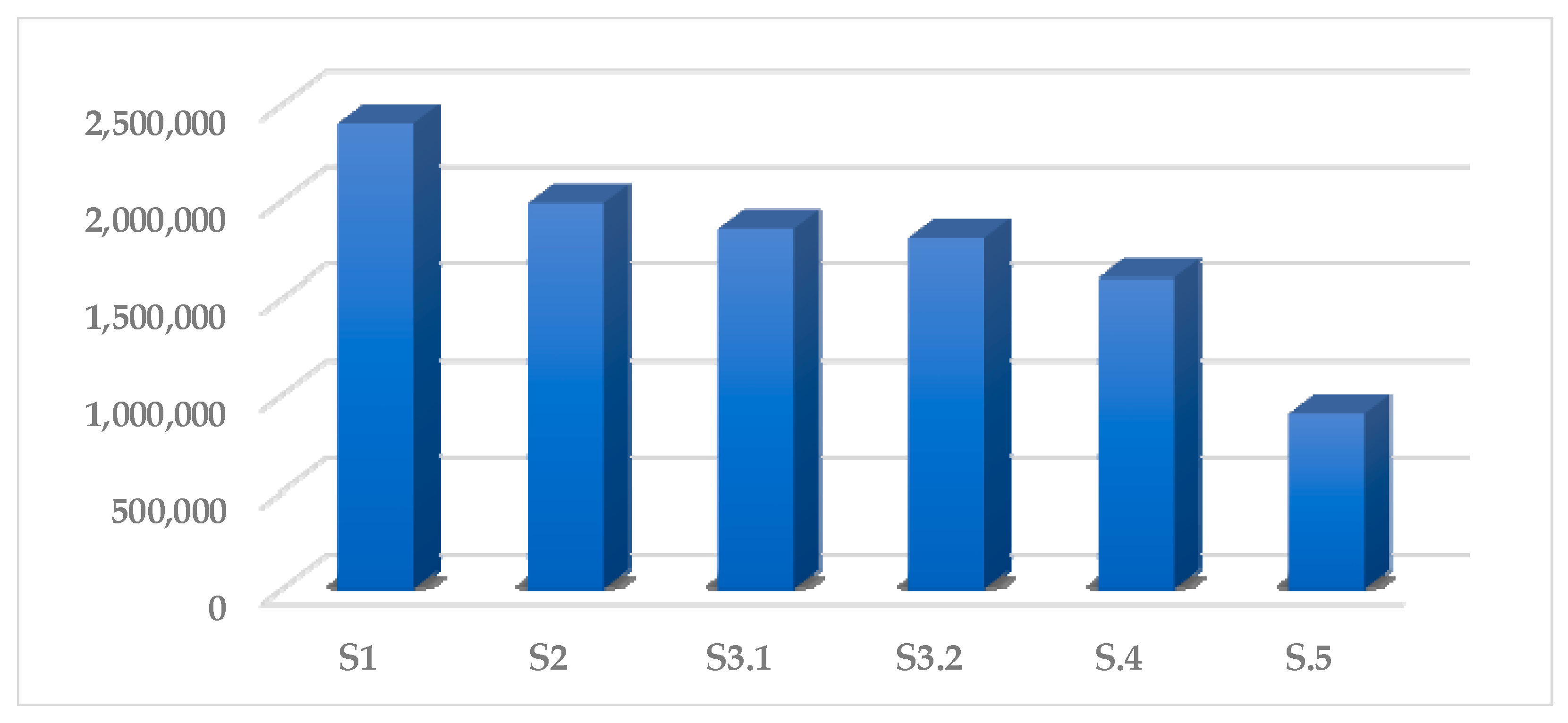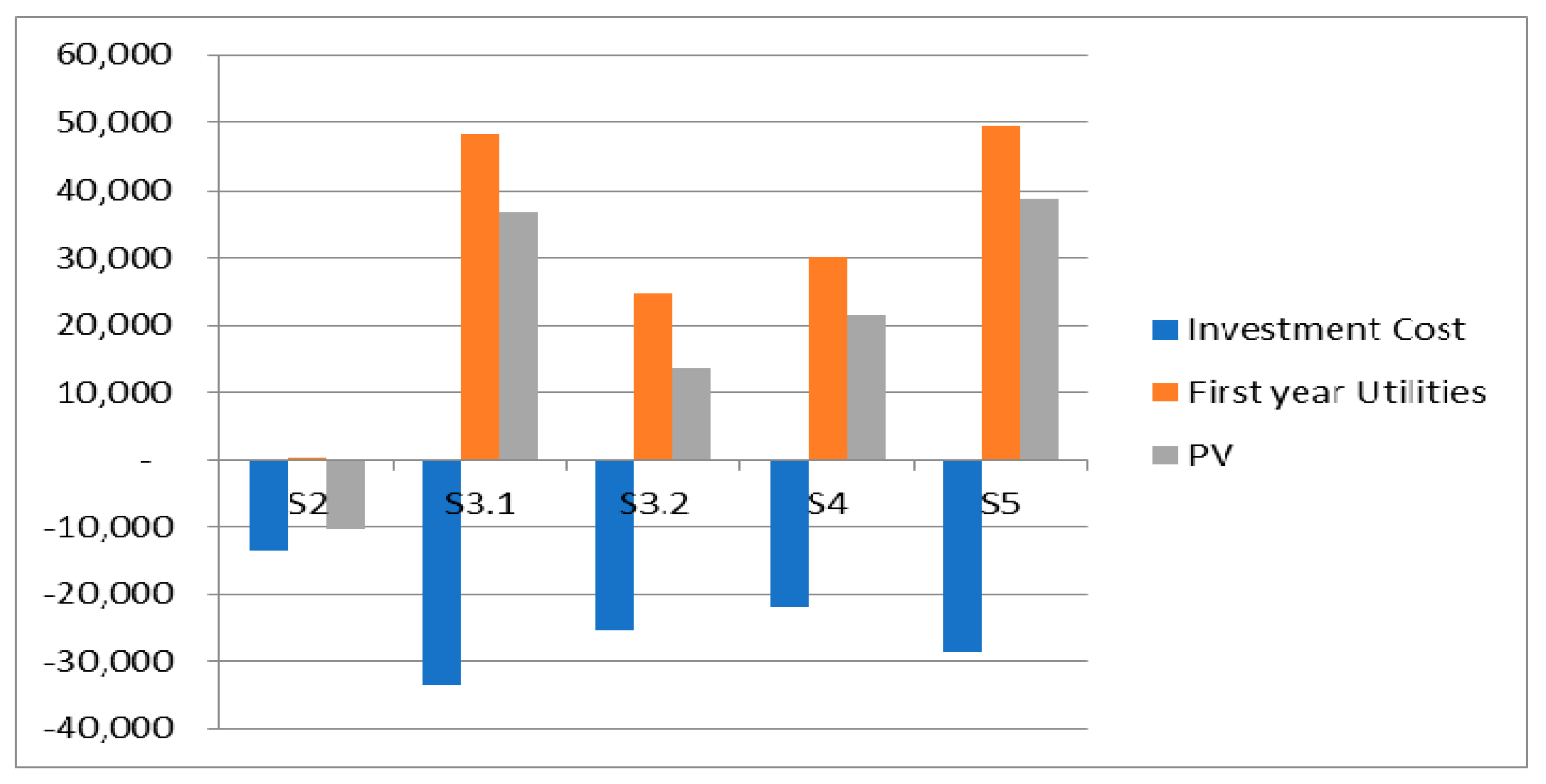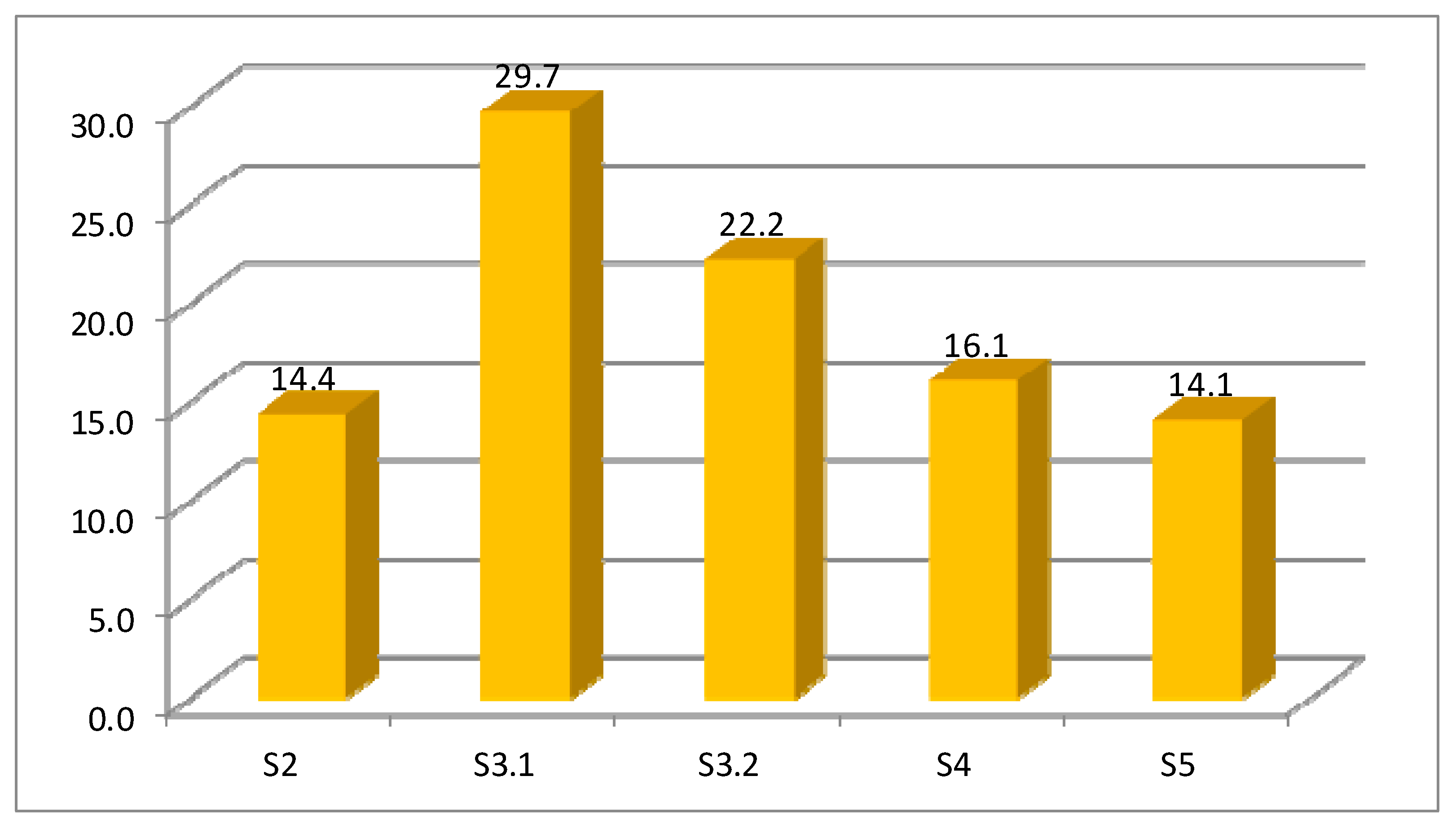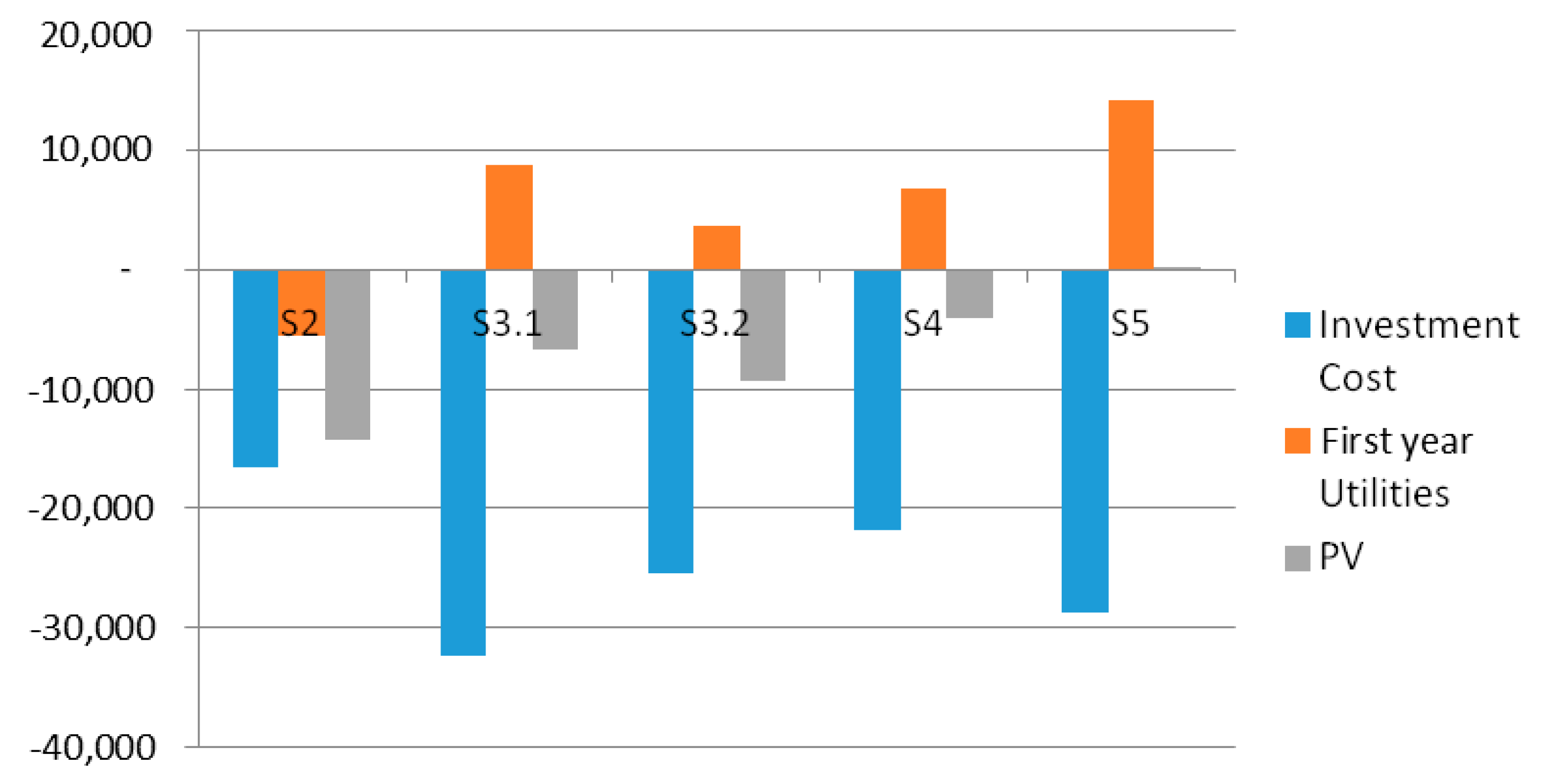4.1. Drop-Off Collection System
As mentioned before, the government is working on a Santiago Recicla project that intends to invest in the installation of clean points in different districts in Gran Santiago.
S2 maintains the status quo for the informal and formal sector and only increases the location of drop-off stations. S3.1 maintains the status quo of the informal sector and improves the formal collection and drop-off stations. To reach each of these target scenarios, it is necessary to increase the waste collected through drop-off by 1314% and 1096%, respectively, compared to S1.
Table 6 shows the number of stations necessary to cover this increase in demand; the numbers are overwhelming. The results show that each municipality will have to allocate and manage approximately 16 drop-off stations. Even if the municipalities decide to install only the biggest-capacity stations, the numbers will still be in the hundreds.
The problem with this system is determining who will oversee the collection of materials. If the municipality oversees the collection, that requires additional expenses and constant monitoring, but if recycling companies oversee the collection, there would be the problem of collection frequency (companies usually wait for a few stations to be full before collecting the materials, leaving some stations overflowing with recyclable materials and not allowing people to continue depositing there). This is a big problem that happens nowadays with this type of material collection method. The location is also a problem. The center area of the study is where commerce is carried out; therefore, to allocate this number of stations seems extremely hard to do.
Another alternative will be to make the informal recyclers in charge of the collection of the materials accumulated in the drop-off and clean points; however, that does not solve the problem of storage for the informal recyclers. Storage capacity is the most important limitation that prevents informal collectors from getting better prices from recycling companies and increasing the amount they can collect [
24].
These numbers show that only increasing the amount of drop-off stations is not a feasible option to reach the governmental target. Therefore, S2 is not a recommended system.
4.2. S3.1 and S3.2 High Recyclable Materials Collection Ratio
By comparing the scenarios in S3, as shown in
Table 7, it is possible to notice how the informal recyclers’ participation affects the collection ratios and increase the system collection efficiency. In scenario 3.1 to reach the 25% recovery target it is necessary to force the collection of some of the recyclable materials to almost 100%, which is a very difficult task. There is also a higher loss of waste compared to S3.2. The loss of materials that are collected but not recovered is 12.4% because of the low treatment efficiencies of the MRF stations—especially regarding paper and glass, which are well-established recycling industries in Chile. However, these materials have high collection efficiencies by informal recyclers. The results show that in S3.1, to recover 59% of paper, 98.3% should be collected. Likewise, glass needs a 97.8% collection ratio to recover just 27%.
Plastic was the only material whose recovery ratio could not be increased further, although its collection ratio is still low compared to other materials. This is because film plastic is not considered a recyclable type of plastic in this study. Therefore, 48% is the maximum of plastic that can be recycled. This is different to Japan, where most plastic can be recycled thanks to energy-recovery treatments that in 2011 recycled 52% out of the 78% of plastic waste recovered that year [
36].
To reach the recycling target in S3.1 it will be necessary to have a collection of almost 100% of rigid plastic, specifically plastic bottles. This is higher than the collection ratios of experienced countries like Japan, the United States, and Europe, with approximately 72%, 28%, and 48%, respectively, in 2004 [
37]. It must also increase the recovery of the “other” category, which means assuming a high recovery of textiles, wood, bulky waste, and batteries, yet those materials are difficult to collect with only drop-off stations. Therefore, S3.1 is not a feasible scenario either.
Thanks to the high recovery efficiency of the informal recyclers (mono collection) for paper and glass, S3.2 can reduce the pressure on plastic recovery. Moreover, it improves the overall collection efficiency ratios, diminishing the residues that will end up in landfill.
S3.2 also has a high collection ratio, although not as high as S3.1. Discussions on this matter will be conducted in point 4.6.4 of this study.
4.3. Importance of the Inclusion of the Informal Sector in the MSWMS
Point 4.2 of this study shows how relevant the inclusion of the informal sector is for increasing the collection/treatment rate. However, the process of including the informal sector is a complicated one that would include many governmental entities. This proposal is a simple first step that will allow a better flow of information and increase awareness.
Even though in Santiago and other regions some informal collectors have formed organizations to achieve better income, there is still no information about the area they work on, specific materials they collect, or if they work based on a specific schedule. All this information is available for citizens regarding formal collection thanks to the municipalities. However, so far there is no information regarding informal recyclers.
As
Figure 7 shows, the municipalities need to become an intermediary between the collectors and the community, making the informal collection part of the formal system. For this, citizens need to receive information about the informal recycling schedule from an official source—the municipalities. This will help with gaining acceptance from the community.
4.4. Selection of the Most Suitable Scenario
As explained at the beginning of this research, this study first intended to identify the scenario that has the lowest CO2eq emission reduction cost.
The environmental air pollutant emissions for each scenario are shown in
Figure 8. Since S5 is the scenario with the highest collection of organic materials, it has the highest potential reduction of CH
4, reducing approximately 30% of the S1. This reduction accounts for 8.5% of the national CH
4 emissions and 24.5% of the national waste sector CH
4 emissions [
20]. The negative numbers represent the emissions avoided due to recycling of materials. For example, in scenario 3.2, the emission of 3000 tons of NO
X can be avoided.
As expected, the more organic materials are recycled, the more GWP is reduced since CH
4 is equivalent to 21 times CO
2, as shown in
Figure 9. In this case the highest reduction is accomplished in S5, which can reduce Chile’s CO
2eq emissions by 3.5% according to data from 2006 [
38].
Regarding the utilities, as can be seen in
Figure 10, except for S2, all the scenarios produce a positive Present Value (PV) after one year of operation because of the high income from selling the materials recovered by the formal sector (the sale of materials recovered by the informal sector and drop-off points are not considered in this analysis).
For the first year of operation, 10% of the sales will be considered as expenses. The facility operational costs, the savings in landfill costs and the landfill cost for the disposal of residual materials after collection are also considered.
Figure 10 shows how attractive the industry of recyclable materials is in terms of cost-effectiveness. This explains why the number of recovery companies has risen in recent years in Chile, from 33 companies in 2000 to 137 in 2009, an increase of 315% [
16].
A good example of this is the experience of the municipality of Ñuñoa, which in 2003 installed an MRF station with an investment cost of approximately $233,000. This facility’s recovery of materials increased from 684 tons in 2003 to 2374 tons in 2011, earning $30,330 and $194,329, respectively, and recovering the investment after four years of operation ($272,883).
This study shows that, to reduce CO2eq emissions, municipalities do have to make an initial investment, but that investment can be recovered rapidly.
For scenarios 3 to 5, municipalities get revenues and achieve a reduction of CO
2eq. In this case, the scenario that reduces CO
2eq by the most, S5, is also the one that has the highest PV. Moreover, if we look at the ratio of investment cost and CO
2eq reduced, shown in
Figure 11, we see clearly that the lowest cost is also achieved by S5.
All scenarios have a lower CO2eq reduction cost than the $36 used by the United States Environmental Protection Agency (EPA) as CO2 social cost (a 3% discount rate for 2015). However, all scenarios have a higher cost compared to the California carbon trade price for 16 January 2016, with a value of $13.21 per ton of CO2eq, with S5 and S2 being the closest followed by S4.
However, as shown in point 4.1, S2 is not a feasible scenario. Therefore, S5 is selected for the continuation of the analysis.
4.5. Potential Benefits of Scenario 5
Regarding the social benefits, the informal recycling sector could provide between 4962 and 24,811 people with a source of steady income. This will have the positive effect of improving the poverty level, which is currently at 14.4% [
39]. Moreover, approximately 708 new job positions could be created for the operation and maintenance of seven MRFs and 34 composting and vermiculture plants.
As for air emissions, since Santiago has been declared a PM
2.5-saturated zone in recent years, PM reduction is very important. Scenario 5 diminishes 4262 tons/year of PM and is also the scenario with the highest reduction of GHG emissions, contributing a 3.5% GHG reduction emission at a national level [
20].
Thanks to the energy savings associated with the recycling of paper, cardboard, plastics, and glass, companies can save, in total, approximately $1203 million.
4.6. Feasibility of Scenario 5 Implementation
In order to achieve the recovery target of 37% of waste in S5, and considering the collection and treatment efficiencies (
Table 3), it would be necessary to collect 44.9% of the generated recyclable waste, as shown in
Table 8, which means that 17% of the collected waste will end up in landfill. In this scenario glass needs the highest collection ratio to because of its low treatment efficiency in MRF. The same occurs with paper and carboard. The informal sector has a high efficiency recovery for these two materials, however it is difficult to increase further their participation ratio because of the high amount of materials in total that they will need to collect in this scenario—40.1% of the total collected waste for recovery.
4.6.1. Mono Collection
According to the share of the two mono collection types and the mixed material bank collection (
Table 5), the collection ratio for each method is 40.1% and 59.9% respectively.
One of the assumptions of this study is that in the mono collection the participation of the informal sector and the drop-off/clean points is 90% and 10%, respectively, for scenarios 3.2, 4 and 5. Hence, the informal sector will have to collect and treat, in S5, 595,465 tons of waste, which represents an approximate increase of 58% over the current situation. Therefore, if we consider that an informal collector recovers between 2 and 10 tons per month of recyclable materials [
25], then between 4962 and 24,811 informal recyclers are necessary to reach the target. To achieve this, nine storage centers will be required, as shown in
Table 9.
In addition, the drop-off and clean point centers will have to collect 66,163 tons of municipal solid waste, which represents an increase of 132% relative to the current situation. For that it will be necessary to install 84 drop-off and clean point stations, as also shown in
Table 9.
The municipalities of Santiago and their surroundings, like the municipality of Independencia, have a high waste generation per capita rate because of the commercial and governmental activities in these districts. Hence these areas will be ideal candidates for the installation of storage facilities. This will allow informal collectors to transport waste using their carts, which is their most used method of transportation.
La Reina and Maipu are municipalities where there are informal collectors’ organizations, so these are also potential locations. La Pintana has already informed their community that they must give recyclable materials to the informal collectors, making it another potential location.
4.6.2. Formal Collection and Treatment of Inorganic Waste
This type of collection is provided by a municipality service. The formal collection sector will have to collect 575,100 tons of waste and take them to the MRF stations for treatment. This represents an extremely high increase compared to the current situation, where approximately 6000 tons are treated. Therefore, it is in this area where most of the investment is needed.
Table 9 shows the number of facilities necessary to treat the huge amount of waste.
Since there are five treatment centers with a high capacity of 110,000 tons per year, these facilities must have easy access and be in an industrial zone because of the noise of the operations. The other two facilities, with 20,000 tons capacity, should be located in places separate from the previous five to achieve better coverage of Gran Santiago. In this case, the location sites should be in the eastern part of Gran Santiago.
4.6.3. Collection and Treatment of Organic Waste
The collection of organic waste is provided by a municipality service. Another assumption of this study is that 50% of the organic waste is going to be composted and the other 50% will go for vermiculture.
Table 9 also shows the number of plants required for organic waste treatment. Since there are 34 municipalities included in the study, one alternative for the siting of the plants would be that each district treats its own organic waste. This will motivate areas with low income to increase their green areas, using compost as fertilizer and therefore diminishing their maintenance costs. The second alternative is to concentrate the treatment in only some municipalities, for example by considering the district that have a high proportion of green areas. In this way it is also possible to concentrate efforts on information diffusion for vegetable separation and obtain higher levels of participation. It is important to consider that it might be inconvenient to have vermiculture or compost plants in municipalities with high population density and few green areas.
4.6.4. Governmental Recycling Target for 2020
Scenarios 3.1 and 5 have an inorganic material recovery target of 25%. When compared to other countries like Japan, which implemented its waste recycling initiatives in the 1990s [
40], Chile is extremely underdeveloped, especially with regards to waste management regulations and the involvement of stakeholders. Moreover, Chile has just started to improve and coordinate national waste management systems after the establishment of the Ministry of the Environment in 2010. Before that, there were only two extraordinary cases of individual municipalities that improved their systems by setting their own goals and priorities since 2005 (La Pintana and Nuñoa).
The 3Rs concept (Reduce, Reuse, and Recycle) is still new in Chile and is not integrated in the waste management system. In May 2016 the government approved Law 20920, which establishes the framework for waste management, Extended Producer Responsibility (EPR), and promotes recycling [
41]. However, it only mentions that municipalities should help companies recover their waste, without further regulations about its execution.
Observing the recovery ratios for different countries shown in
Table 10, the Chilean target seems too optimistic—especially considering that there are only three years left to reach this target. In this sense, S4 is more feasible than S5.
Regarding composting, S5 involves a 12% recovery of waste for composting. This goal seems to be conservative in comparison to other countries. It is also based on a local composting expert municipality goal target; therefore, the organic recovery target can be considered feasible.
4.6.5. Amount of Material Collected or Sold (Sensitivity Analysis)
This analysis considers that the efficiency assumptions made for collection and treatment stages are not achieved as initially proposed in this study. There could be cases where the public participation is lower than expected, MRF treatment efficiency is low and/or lower capacity of the recycling companies. Under these conditions municipalities need to sell at least 34.25% of the total amount collected for recycling (
Figure 12).
As for the other scenarios, the minimum % of the targeted recovered materials are 45.1%, 63.9%, and 45.8% for S3.1, S3.2, and S4, respectively. We can refer to this % as the efficiency of the system.
4.6.6. Price of Recovered Materials (Sensitive Analysis)
An increase in the supply of recyclable materials might cause a decrease in their price. There might also be an increase in the price of raw materials. Based on these assumptions, the study also conducted a sensitive analysis assuming up to 50% variation for paper, cardboard, plastic, and aluminum.
As shown in
Figure 13, if the price of aluminums increase by 10–20%, then scenario 3.1 has a higher PV than all other scenarios because it is the most sensitive to price variations. The same happens with paper/cardboard and plastic.
